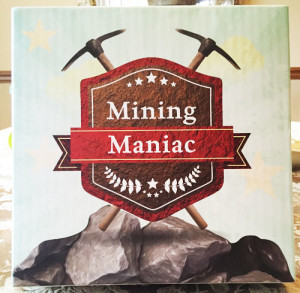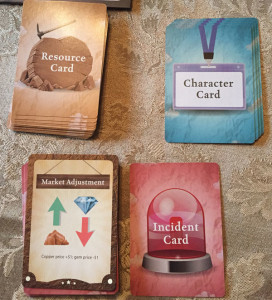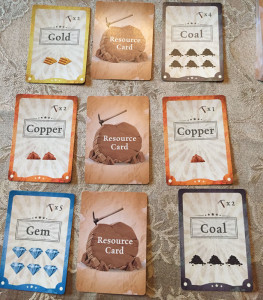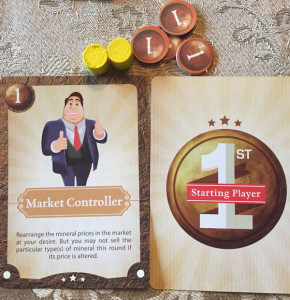 Many thanks to Andrea for sending me this to review. Her design is a unique game that is just revving up on Kickstarter, so check out my thoughts to see if this is something you want to pick up! As always, leave your comments below to let me know of any questions or concerns you may have. Enjoy!
Many thanks to Andrea for sending me this to review. Her design is a unique game that is just revving up on Kickstarter, so check out my thoughts to see if this is something you want to pick up! As always, leave your comments below to let me know of any questions or concerns you may have. Enjoy!
Overview:
Game: Mining Maniac
Designer: Andrea Tsang
Artists: Chung Fong and Vincent Tang
Publisher and Date: X-Axis Production, 2014
Players: 2 to 4, but up to 6 with a future expansion
You’ll like this if you like: Harbour and other market manipulation games.
In Mining Maniac, players act as executive officers of their own mining companies. The object is to amass the most cash by the end of the year, sabotaging your competitors and dodging their attacks along the way. Choose from among your best workers to go out and mine for precious gems, coal, copper, and gold. You can sell the minerals at their current market price, or hold out until next month when they’ll be worth more money. But watch out for unexpected events like collapsed mines, taxes, labor strikes, market crashes, and landslides; these obstacles will hinder your progress and affect the profits of your company!
Rules:
Begin by setting up a three-by-three grid of mineral cards, face down, to act as your “survey deck.” Each card has a different resource on it (gem, gold, copper, or coal), along with the number of workers needed to mine that specific resource card. Give two worker tokens to each player, and put the rest to the side to form a supply. Set up your market by shuffling the price cards and assigning them to each mineral on the market board. Shuffle the 24 incident cards, and put twelve of them out to form the incident deck. Depending on the number of players, prepare the worker deck for the start of the game. You’re now ready to get mining!

For each new month/round, the following occurs:
1) Shift all the price cards one space to the left to determine the market for that month.
2) Players secretly pick a card from the character deck. The characters represent different people who work for your mining company, and their cards include their rank and special ability.
3) Draw an incident card to see which potentially disastrous event will occur this month.
4) Determine turn order, which goes by rank. Whoever picked the highest-ranked character (closest to number one) plays first, followed by the next number, and so on.
5) The active player performs their character’s special ability, and then rolls the die. The result indicates which row or column will be turned over on the grid to reveal or hide minerals. Any mineral that was face down turns face up, and vice versa.
6) Players perform two of three actions: hire workers, gather minerals, or sell minerals. You can hire workers by paying one dollar to the bank and collecting a token from the supply. Gather minerals by placing the indicated number of workers on a face-up mineral card in the survey deck, adding that card to your hand and returning the workers to the supply. To sell minerals, pick a mineral card from your hand and gain money based on the amount and its corresponding price on the market board. For example, if you have a gem card with five gems on it, and the market price for gems is $2, you would make $10 by selling it. After all players have performed these two

actions, a new month begins and the next person becomes the starting player.
The game ends when all twelve incident cards (representing one year) have been executed. The player with the most money wins the game. Ties are broken by whoever has the most resources or workers.
What I liked:
I was a bit hesitant on this game, as I usually don’t like these mechanics. The thought of running a mining business and working within the confines of a stock market doesn’t grab my attention. But reading the rulebook impressed me, and ultimately changed my mind. While there were a few typos, everything was explained clearly, with plenty of examples and straightforward instructions. There is a glossary and FAQs section near the end, which is something more games should do. At this point, the game felt more accessible to me, and it made me want to give it a try. I’m glad I did, because my gaming partner and I ended up loving it! It has a lot going on and feels chaotic at times, but it’s easy to learn, teach, and play.
The artwork is simple, with a clean aesthetic that highlights the crucial information. I thought its simplicity added to the theme, as it’s what I call “business bland” – a mixture of muted colors, serif fonts, and computer-generated images. Initially, I was a bit turned off by it, but I found it to be immersive and effective in creating atmosphere. The component quality is pretty good, with a nice finish on the cards. My copy is pre-retail, and Andrea told me all future copies will have thicker coins; the ones that came in my game were flimsy and hard to punch out.
Gameplay itself is a nice combination of strategy and randomness. There were times when the roll of the die or the luck of the draw screwed us over, but we felt the game allowed us to make enough meaningful decisions to keep it interesting. The character selection process is especially brain burn-y, as you have to debate with yourself whether it’s important to choose a higher-ranked card to keep yourself safe, or a lower one to screw over your

opponents. But that screwing over is hit-or-miss, as you must first name the character you want to attack – if no one else has that named character, you cannot perform the attack. If a player does have the named card, that player will either lose a mineral card of your choice or return half their workers to the supply. Also, you have to decide when to sell or hold on to your minerals. If you have gold bars, and gold is at $2, do you sell them now, or risk a future incident next turn to sell them for $3? Since some of the character and incident cards allow you to manipulate the market or remove mineral cards from players hands, you have to weigh the risks with the rewards.
Mining Maniac is a potentially nasty game, which makes this fun to play with highly-competitive people. This also means a lot of players won’t like it, which is understandable; I can only see myself playing this with people who enjoy the occasional trash talking. There are ways to play with less conflict (by ignoring special abilities), but why bother? It’s an integral part of the experience, and reflects the cut-throat nature of business. We found the overall game to be addicting; the combination of luck, strategy, and organized yet chaotic gameplay kept us going back for more.
What I didn’t like:
Strangely enough, what I loved about this game relates to the main issue I have with it. The randomness is fun, but when I played with my mom, her string of bad luck affected her enjoyment of the game – which then affected my enjoyment. For some players, the incident cards can be real downers and drastically change the feel of the game. That said, this isn’t something I’d bring to a new group or play with those new to games. Mining Maniac seems like it was made for people who know each other well and for those who can gauge player’s sensibilities toward such attack-heavy mechanics. If someone is having a miserable time because they keep being targeted, that can impact everyone else.
For the most part, I played this with two players, which really worked for us. There is potential for analysis paralysis when choosing your character card, so with two players, there isn’t much downtime. It slogs a bit with three, and I imagine it’d be even slower with more players. You can’t really think too far ahead as the market is

constantly changing and events can completely derail your best-laid plans. This inability to plan makes the downtime drag more.
In my copy of the game, the worker tokens are round, so they roll around a lot. It seems like they are switching to meeples in the Kickstarter, as this was a problem I had with keeping my workers together.
Last but not least, I am not that fond of the name. It may seem pedantic, but I wish the designer would have avoided the word “maniac” altogether. Which brings me to my next thoughts…
The Gimp Glimpse:
This game does not rely on color at all to convey information, so it is friendly for color-blind players. The text on the cards is a nice size, and the contrast works well in distinguishing text from background colors. The rulebook has a tiny font, but there is a pdf readily available online. There is a bit of card handling in this game, as you have to shuffle the character cards every round, and go through them each time to choose your role. However, everyone gets player aids that list all the characters, their ranks, and special abilities. This was extremely helpful to me, as I didn’t have to look at each character card individually; I just had to look at the top of the cards to see their numbers, and reference the aid to pick my character. The die is light-weight, so it rolls easily – though it is a wood color, and blended into our similarly-colored tablecloth. Adjusting the market and flipping over cards repeatedly throughout the game might prove troublesome for those with fine-motor skill issues.
Score:
3.5 out of 5. Not a game for everyone, but I certainly had a blast with it. It’s easy to set up and get into, making this one you want to play over and over again. I recommend it for fans of market manipulation who want something with heavy player interaction. Even if this theme is not to your liking, you should give this a try. You can find Mining Maniac at the following link: Kickstarter (click me).
